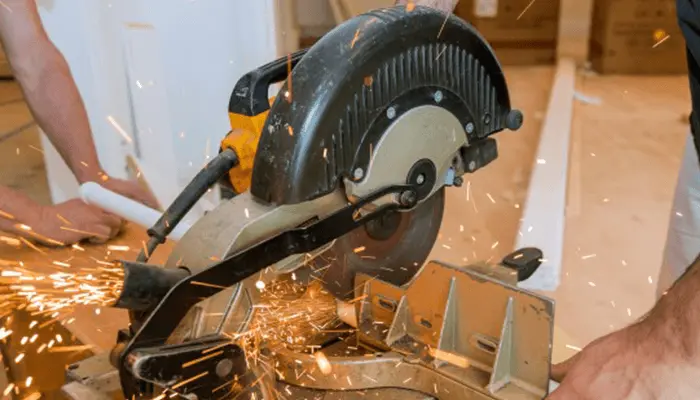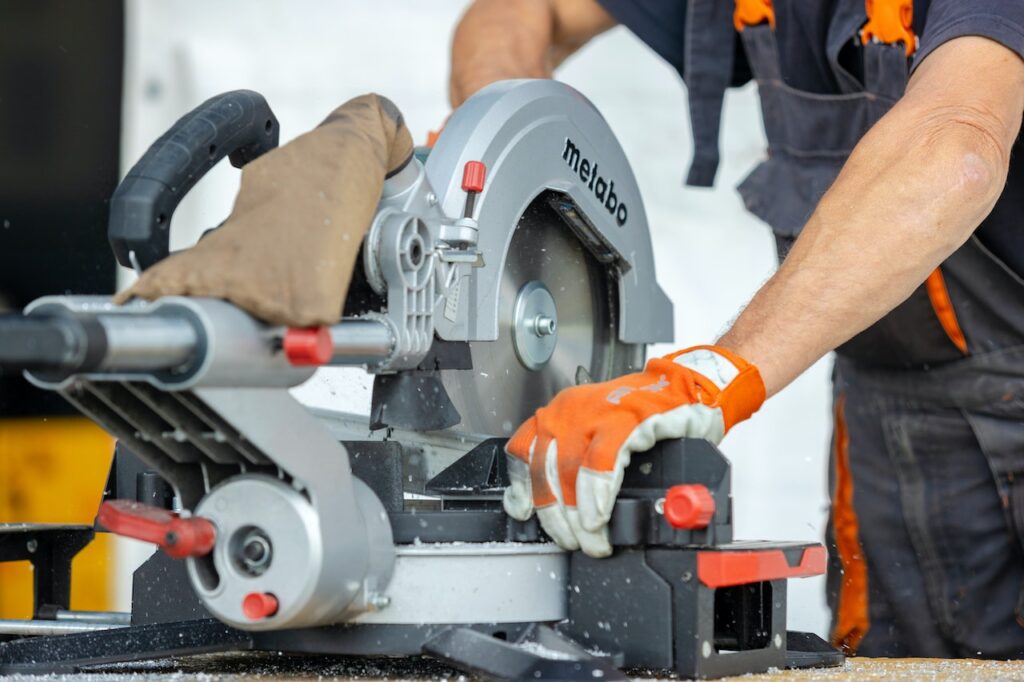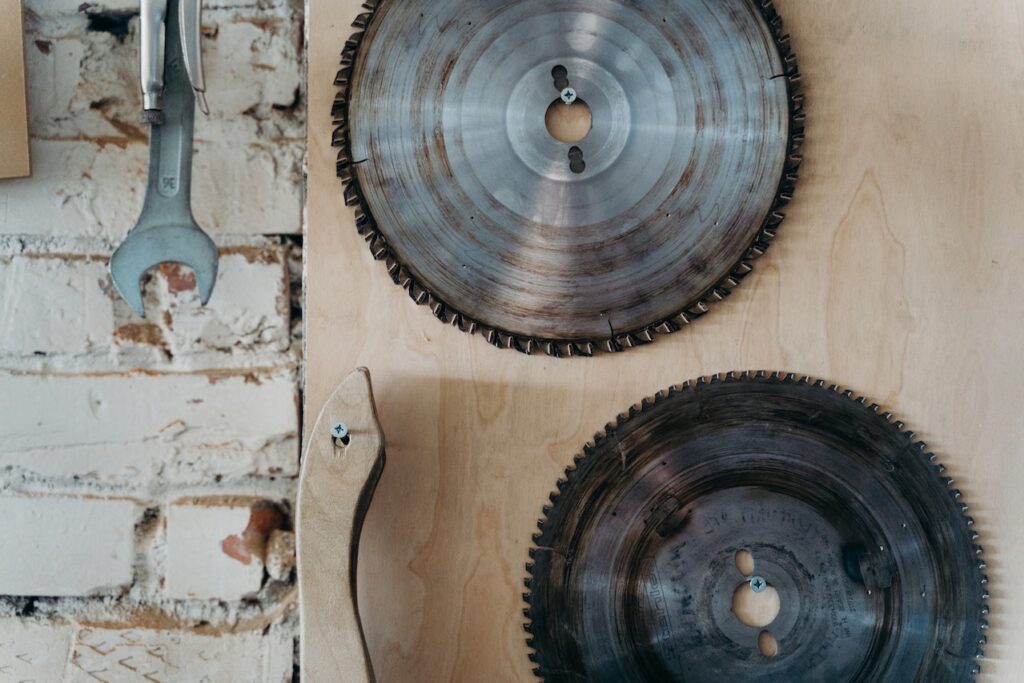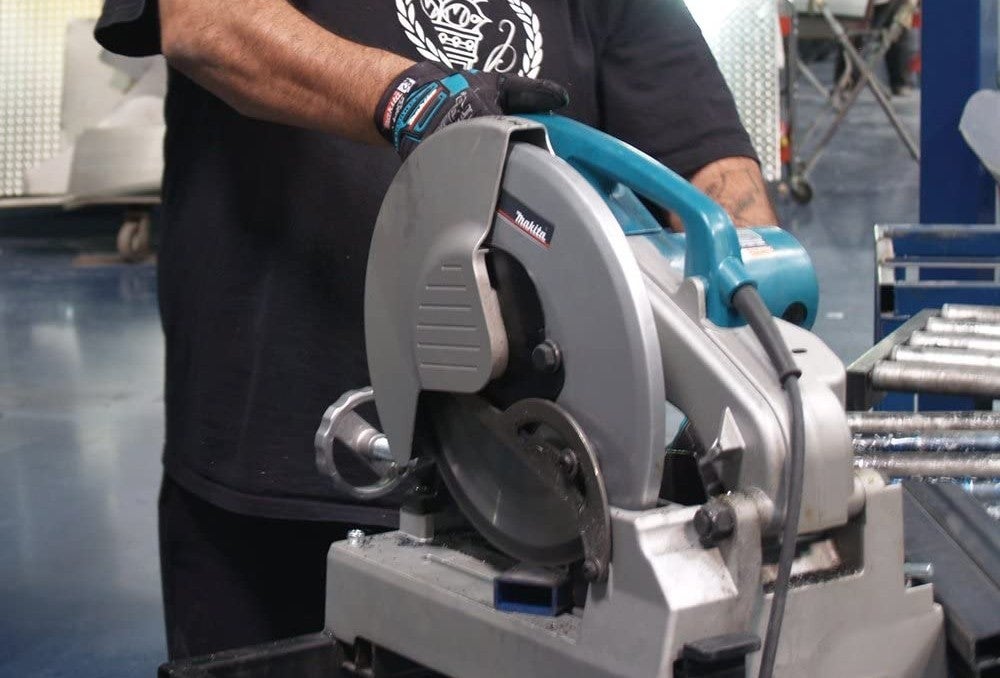Are you willing to learn how to use a chop saw to cut metal for your DIY project? You’ve come to the perfect place if you’ve ever needed to make accurate, clean cuts on metal objects. A chop saw, often called a cut-off or abrasive saw, is a strong instrument made especially for quickly and easily cutting through various kinds of metal.
In this guide, we’ll take you step by step through the process of using a chop saw, covering everything from choosing the right blade for your job to taking the required safety precautions. Whether you’re an experienced expert or a DIY enthusiast wishing to improve your abilities, this guide will provide the information and assurance to make precise and professional-looking cuts.
Characteristics of a Chop Saw
A chop saw is a useful tool for cutting things. You want an optimum cut—smooth ends without burning and clean edges—if you are cutting stock that is going welded or wants a desired end that does not need to be machined. There is no need for further finishing, including grinding or polishing. The material is immediately handleably cool to the touch, and there is no heat buildup.
Unlike other methods, chop saws produce little heat, no burr, and essentially no sparks while cutting steel, leaving an immediately usable finish. Metals may be cut more precisely and safely with chop saws. It efficiently and neatly slices through metals. It cuts through metal faster than any conventional technique, including abrasive wheels.
The Different Types of Chop Saw

Chop saws, often called drop saws or mitre saws, are power instruments frequently used to make accurate and precise cuts in various materials, including plastic, metal, and wood. Chop saws come in a variety of designs that are suited for various materials and uses. Here are a few typical examples:
📝Compound Miter Saw
This kind of chop saw can concurrently create bevel and mitre cuts, which are both angled and diagonal. It is appropriate for framing, crown molding, and other woodworking applications because it enables the operator to perform compound cuts in two planes.
📝Bevel Miter Saw
With dual-bevel chop saws, bevel cuts may be made without flipping the workpiece since the blade can be tilted in both directions (left and right). They are frequently used in woodworking & carpentry activities that need delicate cuts and difficult angles.
📝Compound Sliding Miter Saw
Thanks to a sliding function, the blade may travel forward and backward on these saws. Enhancing the cutting capability, this function enables users to cut larger amounts of material. For bigger jobs requiring the cutting of larger boards or panels, sliding compound miter saws are helpful.
📝Standard Miter Saw
This kind, sometimes called a basic miter saw, allows users to perform miter cuts at preset angles and straight crosscuts. Compared to compound and sliding variants, standard miter saws have a more straightforward design and are less expensive. They are appropriate for routine woodworking cutting jobs.
📝Metal Cutting Chop Saw
These chop saws, specifically made for cutting metal, include a high-speed abrasive and a toothed blade suitable for metalworking applications. They offer clean, accurate cuts in copper, aluminum, and steel.
📝Abrasive Chop Saw
These chop saws cut through materials, including masonry, metal, & concrete, by using abrasive wheels. They are frequently employed in plumbing, metalworking, and building projects.
📝Cold Saw
Chop saws with unique metal-cutting blades are called cold saws. For keeping the blade & workpiece cool during cutting, they employ a toothed blade and a coolant or lubricant. Cold saws are renowned for creating precise, burr-free cuts in metal materials.
These are a few of the typical designs of chop saws. The exact cutting requirements, kind of material, and desired characteristics for the project all influence the chop saw selection. For precise and effective cutting, choosing the right chop saw is critical based on the intended use.
How to Use a Chop Saw to Cut Metal

Do you need to utilize a steel chop saw for any tasks? This article may be useful. The friction blades these cut-off saws use are all the same size—355 x 3.0 (diameter of center hole). As you use them, they steadily deteriorate until they’re too little to cut. Here is the step-by-step guide to cutting metal using the chop saw.
⚙️Ensure the Chop Saws are in Good Condition
Ensure that your saw is in good working condition and can cut the material you’re using. With the right blade and support, a fourteen-inch (35.6 cm) saw can effectively cut through the material around five inches (12.7 cm) thick. Make that the switch, cable, clamp base, & guards are in excellent working order.
⚙️Provide Enough Power
Ensure adequate electricity. You should use something other than one of these saws with a long, thin extension wire since they normally need fifteen amps minimum at 120 volts. When cutting outside or at a location where an electrical short can occur, you might also select a ground fault interruption circuit if available.
⚙️Select The Right Blade
Select the appropriate blade for the given material. Faster-cutting abrasive blades are thinner; a little thicker blade may withstand more damage. For maximum results, choose a dependable blade from a retailer.
⚙️Utilize Safety Equipment
While cutting, protect yourself by using safety gear. Eye protection, especially a face shield, is advised because these saws produce dust, sparks, and debris. You might also wear heavy-duty long trousers, sleeved shirts, work boots, thick gloves, and hearing protection for added security.
⚙️Setup the Saw Properly
When cutting a flat bar, position the piece vertically in the clamp so the entire cut is made through a thin layer. The blade has difficulty clearing the kerf (cuttings) while cutting over a flat surface.
Set angle steel on the two edges to prevent cutting through a flat surface.
Put some cement sheet, iron, or (as long as you keep an eye on it) damp plywood below the chop saw if you place it directly on concrete. That will prevent the concrete from being permanently stained by the sparks.
You will frequently need to use a chop saw when it is on the ground. This is due to the material’s length and weight, which you may choose to trim. Use packers to back up the steel after placing something flat and sturdy below the saw.
Be sure to shield any nearby elements, such as windows or walls. Remember that the saw’s back is where sparks & debris are ejected at fast speeds.
⚙️Inspect the Setup
If the ground is uneven or your packers are in error, use a square to ensure that the disk’s face is square off the steel.
You should be fine if packers to the correct are a little low. As you cut, this will enable the cut to open up slightly.
Never position your packers high and even level, and by all means, avoid positioning yourself on a bench. As you cut, the center of the steel will sag, causing the chop saw to attach and finally jam.
⚙️Clean the Blades
Metal and disk debris accumulates inside the steel guard of a saw after some time of operation. When you are replacing the disk, you will notice it. Use a hammer to smash the guard’s outside to loosen the accumulation. (Of course, when it is turned off. When cutting, don’t take the danger that it may fly off quickly.
⚙️Mark the Cuts First
Mark the material using a fine pencil or a sharp piece of chalk to make an incredibly exact cut if dealing with black steel. Set it up with the clamp slightly pinched up. You can place a tape measure on the material’s end and bring it beneath the disk if your mark is too faint or difficult to notice. Reduce the disk nearly to the tape, then look down the disk’s face to the tape. Look down the cutting disk’s surface as you cut.
You can adjust your eye to observe if the cutting face and the size of 1520mm are exactly parallel.
You should sight down that side of the blade if the desired component is to the right of the disk.
⚙️Avoid Wasting the Blade
To avoid wasting the blade, back off if you are pushing it a little too hard and notice dust coming off the blade; you should hear revs that are not much lower than the idle speed and see lots of brilliant sparks shooting out of the back.
⚙️Utilize Several Techniques for Various Materials
For difficult-to-move heavy material, lightly nip the clamp, then fine-tune by hitting the material’s end with a hammer until it is right. Try striking the saw with a hammer to raise it to the mark if the steel is long and weighty. Increase the clamp’s tension and apply constant pressure as you cut. When necessary, place your tape beneath a cutting blade. All saws need the user to sight down the blade.
Tips on Using a Chop Saw to Cut Metal
➧Wear eye protection, gloves, and ear plugs when cutting metal since this will help prevent harm from flying shards & fragments of metal.
➧Just tape some thin fabric over the apertures and vents to shield the motor from metal chips while operating a mitre saw with an open motor housing.
➧It can be useful to back all metal with pieces of wood to offer support when sawing through hollow or thin-walled profiles, such as aluminum angle, to reduce the chance of the blade snagging on the metal and potentially deforming the metal being cut.
➧Check that the safety cover is in excellent shape, in the proper position and that any cords are out of the cutting area before turning on the saw’s power.
➧To guarantee the cut is accurate, place the work piece on the table, secure it utilizing any vice adjusters and mitre locks, and hold it tightly against the fence.
➧Once your machine is configured to your satisfaction, keep the workpiece pressed against the fence, depress the saw’s power button, and wait for its blade to reach maximum speed before lowering it steadily and gradually through the metal. When the cut is finished, hold the saw lowered and let go of the power button while maintaining a firm grip on the workpiece until the blade has completely stopped moving. Bring the blade carriage back to the upright position after the blade is stationary.
Chop Saw Metal Cutting Blades

Two primary types of metal-cutting blades are available. An abrasive cutting wheel is the earliest and most popular blade form used to cut metal. The second kind of blade is a circular saw blade created especially for cutting metal.
The kind of metal you’d like to use your chop saw to cut will have a big impact on the blade you choose. To achieve a clean cut, use a metal cutting blade with non-ferrous metals like copper, brass, or aluminum. For many years, ferrous metals, including cast iron, carbon steel, or stainless steel, have been cut using abrasive cutting wheels. Prior to the development of modern steel alloy metal cutting blades, the abrasive cutting wheel became the most useful tool for cutting metal.
Your choice of the blade may also be influenced by how frequently you use the saw because abrasive cutting wheels are far less expensive than metal cutting blades. The benefit of using metal blades instead of abrasive cutting wheels is that they stay much longer.
➊Circular Metal Cutting Blades
Chop saws are now far more versatile for cutting different types of metal because of advancements in metallurgy, which have led to the development of several distinct saw blade shapes. We are all familiar with the conventional circular saw blade with teeth used to cut timber. Steel alloy saw blades have become quite common due to advancements in blade design & manufacturing materials throughout time.
Metal-cutting saw blades can have up to 100 teeth each. Naturally, this is based on the blade’s size. Each tooth’s leading edge has a small cutter connected to it that serves as the tooth’s tip. Extremely hard materials, such as tungsten or titanium carbide, make the cutters. With every passing tooth as the blade spins, the very strong saw blade tips allow the blade to cut through most common metals quickly. Cutting blades are sometimes called “cold-cut blades” because they produce little heat when cutting.
The ingenious design of cold-cut blades allows any heat produced during the cutting operation to be transferred to the metal fragments as they are being cut. The shavings are subsequently discharged from the saw or, if the chop saw has one, into its chip collection device. With the variety of sizes and tooth arrangements available, you may use your preferred chop saw to cut almost any form of metal.
The steel cutting blade’s ability to resharpen the teeth whenever they get dull is a key benefit. Unlike an abrasive cutting wheel; the blade does not require replacement as frequently. To guarantee a safe working environment, check that your chop saw’s blade size, arbor size (central hole), & blade rotation speed are compatible.
➋Abrasive Cutting Wheels
There are two main uses for abrasive cutting wheels masonry & steel. The materials utilized to create the cutting disc vary greatly, but they all follow the same fundamental formula for binding a mixture of grit kinds with an adhesive. This mixture is formed around the fiber material to increase the disc’s strength before being molded into its final shape.
Aluminum oxide, zirconia alumina, silicon carbide, and other extremely hard materials, among others, are used to make all abrasive cutting wheels. The idea behind abrasive cutting wheels is that they are physically harder than the materials being cut, allowing the disc to remove material to create a cut. Despite their extreme hardness, cutting wheels are consumable and lose effectiveness over time. When the wheel’s diameter is too tiny to be useful due to wear, the disk or wheel must be replaced.
Tips for Using a Chop Saw Safely

When utilizing chop saws, metal blades, or cut-off saws, shave tiny metal fragments off the surface, forming a cut, to cut through metal. An abrasive disk carries out similar processes but removes considerably smaller pieces of metal from the surface, eroding a cut into the metal. Both cutting techniques discharge debris from the wheel or blade, which might be dangerous.
The robust cutting machine makes a lot of noise during the cutting operation. Thus, it is crucial to wear high-quality hearing protection to prevent permanent hearing loss and to keep hot sparks out of your ears. When cutting using an abrasive or grinding wheel, chop saws produce a lot of hot sparks. When operating a saw, it’s crucial to use good eye protection to prevent accidental contact with hot metal fragments.
We don’t always consider using cotton garments to stop sparks from tearing holes in our clothes. Socks made of nylon are not recommended since they melt very fast when exposed to sparks. Wearing loose-fitting clothes or jewelry puts them at risk of unintentionally becoming caught in the blade.
The metal you’re cutting generates a lot of heat when you use an abrasive wheel. Avoid touching the metal immediately after cutting it since the surface is still hot and might burn you. When using the machine, wearing adequate, high-quality gloves is strongly advised.
Always ensure the workpiece is firmly secured to the cutting table when using a chop saw to cut metal so it doesn’t come free or slide about. Not only will the metal be cut unevenly because of this, but the metal may also clog the blade, endangering it in the process.
Frequently Asked Questions
Can you cut metal with a chop saw?
Chop saws for cutting abrasive wheels are incompatible with slower-speed saws that cut other metals with carbide-tipped blades. For higher-speed saws, you can get certain steel blades.
How quickly can a chop saw cut?
On the other hand, a chop saw wears away at the metal, producing a lot of heat in the process. Although they operate at relatively low RPMs (between 22 and 88 RPMS), cold saws will cut your material more quickly than a chop saw, which operates at about 4000 RPMS.
A chop saw can cut materials up to what thickness?
A third of its diameter is the maximum depth it can cut. In most cases, a ten ′′ saw only cuts up to 3′′ deep. It is occasionally feasible to reduce the blade’s diameter by up to 45%, although doing so typically necessitates removing safety guards; that is not a good idea. Large circular blades frequently operate in this manner.
Can hardened steel be cut with a chop saw?
Metal is tough. An abrasive chop saw is preferable since it utilizes an abrasive disc rather than a saw blade to cut the material; alternatively, you might use an angle grinder, hacksaw, or even a torch.
Which blade size does a chop saw utilize?
Smaller trim miter saws use 7-1/4-in. or 8-1/2-in. blades, with 10-in. or 12-in. blades being the most popular. There are less common sizes. Never use a blade that is a different size than the one advised for your saw; doing so is risky and ineffective.
Final Words
Cutting metal with a chop saw may be quick and easy when used properly. You can accomplish precise and clean cuts while lowering the chance of accidents or damage by following the right procedures and taking the necessary safety precautions. You can successfully cut metal with a chop saw if you follow the instructions and take the appropriate safety measures, whether working on construction, fabrication, or DIY projects. Always put safety first, and refer to the manufacturer’s instructions for your particular chop saw type. Do you want to know the circular saw tips and tricks? Click Here!


